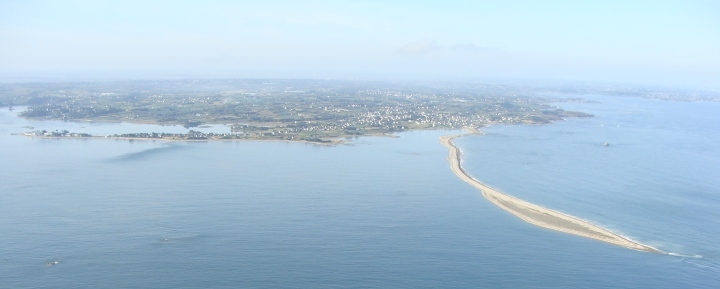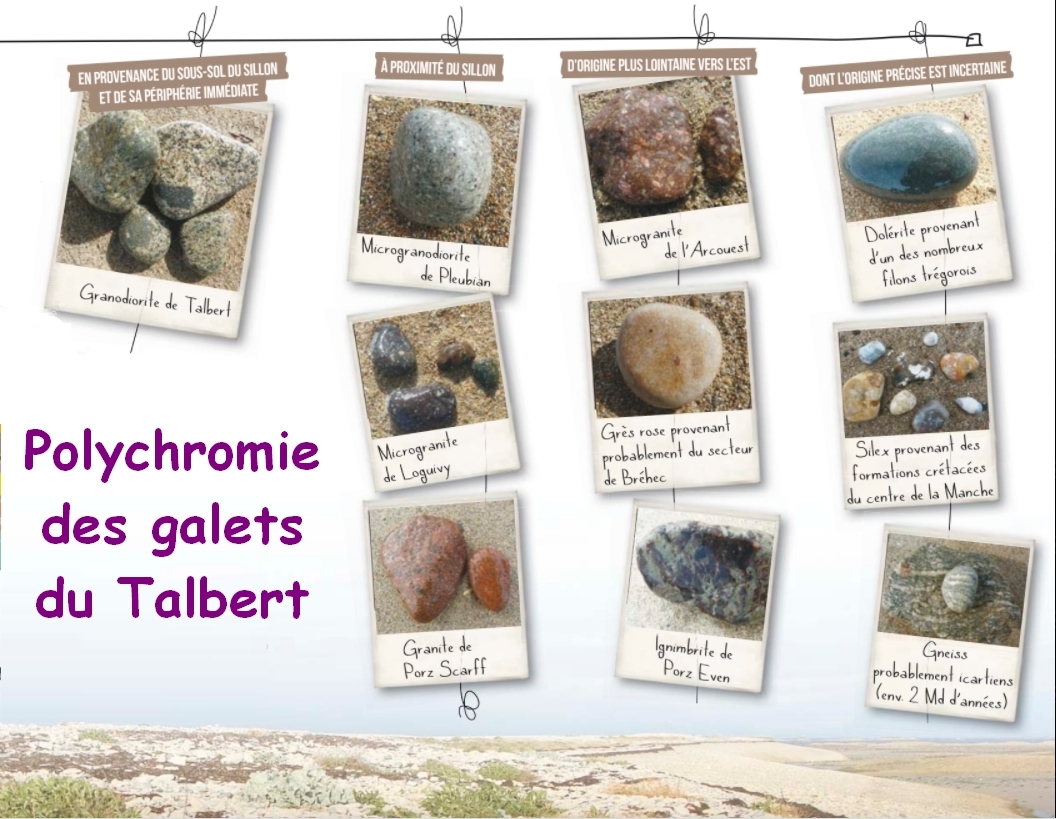VERSION FRANCAISE / ENGLISH VERSION
* * * * *

/!\ ACCESSIBLE A MAREE BASSE /!\
/!\ ACCESSIBLE AT LOW TIDE /!\
Consultez les horaires / Check the timetables

* * * * *
[FR]
LE SILLON DU TALBERT :
Le sillon du Talbert est un site naturel exceptionnel ancré au rivage de la commune de Pleubian, formé d’une accumulation de sable, de graviers et de galets. Ce patrimoine géologique est unique en France de par ses dimensions : une longueur de 3,2 km pour une largeur moyenne de 100 m, sa hauteur varie entre 10 et 15 m avec un volume estimé à 1,23 millions de m3.
Cette structure écopaysagère est à la fois un site d'intérêt écologique (une centaine d’espèces végétales dont 3 protégées, habitat naturel favorable à la nidification d’oiseaux limicoles) et une curiosité géologique.
Ce cordon de galets multimillénaire (environ 6000 ans) s’est formé au gré des évènements météo-marins. Remodelé à chaque marée, il est mobile et évolue en roulant sur lui-même sous l’effet de la houle d’en moyenne un mètre par an vers le sud-est.
Cette curiosité naturelle est toutefois fragile du fait de sa mobilité et de l’activité humaine (notamment par le tassement dû au passage et le prélèvement de galets). En 2018, une brèche s’est formée à 500m du rivage imposant une vigilance accrue des visiteurs.
Réserve naturelle, sensible et protégée cet espace remarquable est classé site Natura 2000.
LES GALETS DU TALBERT :
Les galets qui constituent le cordon présentent un foisonnement de couleurs. Ils proviennent de roches magmatiques ou sédimentaires d’origine locale que l’on retrouve au pied ou au large du Sillon et dans les estuaires du Jaudy et du Trieux. De provenance plus lointaine, des rognons de silex sont également trouvés. À ce jour, 25 formations pétrographiques ont été inventoriées.
=> en provenance du sous-sol du sillon et de sa périphérie immédiate :
- granodiorite de Talbert : roche locale présente en grande quantité, grenue proche du granite mais qui présente des enclaves sombres.
=> à proximité du sillon :
- microgranodiorite de Pleubian : granodiorite formée de micro cristaux blancs (de quartz) et noirs (de micas).
- microgranite de Louguivy : roche microgrenue contenant de cristaux millimétriques de feldspath rosés ou verdâtres lui donnant une couleur gris bleuté lorsqu'il est sec et prune lorsqu'il est mouillé.
- granite de Porz Scraff : granite de couleur rose dûe à la présence d'oxyde de fer (hématite).
=> d’origine plus lointaine vers l’Est :
- microgranite de l'Arcouest : roche microgrenue de couleur rose violine avec des inclusions millimétriques plus pales.
- grès rose provenant probablement du secteur de Brehec : roche sédimentaire formée par la cimentation de grains de sable.
- ignimbrite de Porz Even : roche formée de débris de lave acide issus d'une nuée ardente et soudés avant leur refroidissement mélangés à une matrice vitreuse. Leur couleur dépend de leur composition mais on retrouve plus souvent des gris foncé à gris-bleu.
=> dont l’origine précise est incertaine :
- dolérite provenant d’un des nombreux filons trégorrois : roche magmatique très finement cristallisée composée de minéraux sombres avec une teinte verdâtre à bleuâtre.
- silex provenant des formations crétacées du centre de la Manche : roche sédimentaire siliceuse dure à cassure lisse. Ces nodules de calcaire cristalisé de couleur brune translucide sont enveloppés d'un cortex blanc patiné.
- gneiss probablement icartiens (env 2Md d’années) : roche métamorphique présentant une alternance de plis clairs et foncés.
* * * * *
[EN]
THE TALBERT FURROW :
The Talbert furrow is an exceptional natural site anchored to the shore of the town of Pleubian, formed by an accumulation of sand, gravel and pebbles. This geological heritage is unique in France due to its dimensions : a length of 3.2 km for an average width of 100 m, its height varies between 10 and 15 m with a volume estimated at 1.23 million m3.
This eco-landscape structure is both a site of ecological interest (about a hundred plant species, 3 of which are protected, a natural habitat favorable to the nesting of shorebirds) and a geological curiosity.
This furrow of multi-millennial pebbles (about 6000 years old) was formed according to weather and marine events. Reshaped at each tide, it is mobile and evolves by rolling on itself under the effect of the swell of an average of one meter per year towards the southeast.
This natural curiosity is however fragile due to its mobility and human activity (in particular by the compaction due to the passage and the removal of pebbles). In 2018, a breach formed 500m from the shore requiring increased vigilance from visitors.
A natural, sensitive and protected reserve, this remarkable area is classified as a Natura 2000 site.
THE PEBBLES OF TALBERT :
The pebbles that make up the furrow have a proliferation of colors. They come from magmatic or sedimentary rocks of local origin found at the foot of or off the Furrow and in the Jaudy and Trieux estuaries. From more distant sources, flint kidneys are also found. To date, 25 petrographic formations have been inventoried.
=> coming from the subsoil of the furrow and its immediate periphery :
- Talbert granodiorite : local rock present in large quantities, grainy close to granite but which has dark enclaves.
=> near the furrow :
- Pleubian microgranodiorite : granodiorite formed of white (quartz) and black (mica) micro crystals.
- Louguivy microgranite : micrograined rock containing millimetric crystals of pinkish or greenish feldspar giving it a bluish gray color when dry and plum when wet.
- Porz Scraff granite : pink colored granite due to the presence of iron oxide (hematite).
=> of more distant origin towards the East :
- microgranite from Arcouest : microgranite rock of a purplish pink color with paler millimetric inclusions.
- pink sandstone probably from the Brehec sector : sedimentary rock formed by the cementation of grains of sand.
- Porz Even ignimbrite : rock formed from acid lava debris from a fiery cloud and welded before cooling mixed with a glassy matrix. Their color depends on their composition but more often we find dark gray to gray-blue.
=> whose precise origin is uncertain :
- dolerite from one of the many Trégorrois veins : very finely crystallized igneous rock composed of dark minerals with a greenish to bluish tint.
- flint from the Cretaceous formations of the center of the English Channel : hard siliceous sedimentary rock with smooth fracture. These crystallized limestone nodules of translucent brown color are enveloped in a weathered white cortex.
- probably Icartian gneiss (about 2 billion years old) : metamorphic rock with alternating light and dark folds.
* * * * *
Polychromie des galets du Talbert Polychromy of the Talbert pebbles

* * * * *
SOURCES :
https://fr.wikipedia.org/wiki/Sillon_de_Talbert#cite_note-7
https://www.bretagne.bzh/app/uploads/Plaquette-r%C3%A9serve-naturelle-r%C3%A9gionale-Sillon-de-Talbert.pdf
https://www.tourismebretagne.com/destinations/les-10-destinations/cote-de-granit-rose-baie-de-morlaix/le-sillon-de-talbert/
https://www.cotesdarmor.com/fr/fiche/patrimoine-naturel/sillon-de-talbert-pleubian_TFOPNABRE0220LPQ5C2/
https://www.mairie-pleubian.fr/le-sillon-de-talbert.html
https://www.reserves-naturelles.org/sillon-de-talbert
http://vivarmor.over-blog.com/article-le-sillon-du-talbert-pleubian-historique-et-evolution-geologie-ornithologie-botanique-85751780.html
* * * * *
QUESTIONS :
Pour valider cette EarthCache, vous devez répondre aux questions suivantes à l'aide des éléments ci-dessus et de vos observations sur le terrain :
0) Joignez à votre log une photo de vous (ou objet vous identifiant) sur le Sillon avec le magnifique paysage qui s’offre à vous.
1) Comment s'est formé le sillon du Talbert ? Quel âge a-t-il ?
2) Pourquoi est-il fragile ?
3) Parmi les 25 variétés présentes sur le Sillon, repérez 4 galets différents (par leurs couleurs, grains, …) et prenez-les en photo avec un objet vous identifiant (/!\ les laisser sur place après !).
Décrivez-les et, en vous référant au descriptif, déduisez-en de quelles roches il s’agit ainsi que leur origine. Joignez cette photo à votre réponse ou votre log.
Rappel concernant les Earthcaches : il n'y a pas de conteneur à rechercher ni de logbook à renseigner.
Envoyez-moi vos propositions de réponses via mon profil (nanou1) soit par mail soit via la messagerie geocaching.com (Message Center), et loguez ‘Found it’ en même temps. Je vous contacterai en cas de problème.
/!\ Les logs enregistrés sans réponses seront supprimés.
To validate this EarthCache, you must answer the following questions using the above elements and your field observations :
0) Attach to your log a photo of you (or object identifying you) on the Furrow with the magnificent landscape that awaits you.
1) How was the Talbert furrow formed ? How old is he ?
2) Why is it fragile ?
3) Among the 25 varieties present on the Sillon, locate 4 different pebbles (by their colors, grains, …) and take a picture of them with an object that identifies you (/!\ leave them there afterwards!).
Describe them and, referring to the description, deduce which rocks they are and their origin. Attach this photo to your response or your log.
Reminder about Earthcaches : there is no container to search for or logbook to fill in.
Send me your proposed answers via my profile (nanou1) either by email or via geocaching.com messaging (Message Center), and log in 'Found it' at the same time. I will contact you if there is a problem.
/!\ Logs recorded without answers will be deleted.